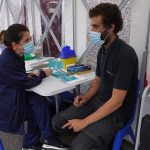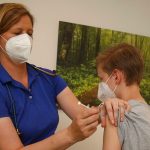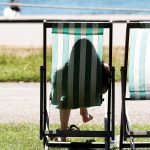Unvaccinated people are 32 times more likely to die from coronavirus than those who have been doubled-jabbed, according to the figures from the Office for National Statistics.
It comes as new data shows one in four older adults who test positive for COVID-19 are no longer following the rules for self-isolating, and separate analysis of figures shows which areas have the highest case rates.
Live coronavirus updates from the UK and around the world
The ONS figures from between 2 January and 24 September 2021, and adjusted for age, showed the mortality rate for the unvaccinated was 849.7 per 100,000, compared with 26.2 for the fully jabbed.
It also showed deaths involving COVID-19 were consistently lower for people who had received two vaccinations compared with one or no vaccinations.
The weekly age-standardised mortality rates (ASMRs) take into account differences in age structure and population size to allow comparisons between vaccination status groups, the ONS said.
This is because vaccinations are being offered according to priority groups set out by the Joint Committee on Vaccination and Immunisation (JCVI), which means the characteristics of the vaccinated and unvaccinated populations are changing over time.
COVID-19: Five million people have now died from coronavirus across the globe
COVID-19: NHS to visit hundreds of schools to offer coronavirus vaccine to 12-15-year-olds to ‘help keep children in the classroom’
COVID-19: High case numbers in schools where not all pupils are vaccinated are ‘ideal conditions’ for new variant – government scientists
In a separate survey by the ONS, around 75% of respondents aged between 35 and 54 said they were sticking to the isolation requirements for the entire 10-day period after testing positive for coronavirus – down from 86% in the summer.
However the figures, based on responses collected from adults in England between 27 September and 2 October, showed the vast majority of people – 78% – are still adhering to the requirements.
This is broadly unchanged from 79% in the previous survey which was carried out in July, but is “significantly lower” than levels seen earlier in the year, such as 84% in April and 86% in May, the ONS said.
Follow the Daily podcast on Apple Podcasts, Google Podcasts, Spotify, Spreaker
Meanwhile, separate analysis of government figures by the PA news agency suggests COVID-19 infection rates are continuing to rise in nearly one in five local areas in the UK, with sharp increases recorded in the East Midlands.
Rates in most areas are now falling, however, with national rates in England, Scotland, Wales and Northern Ireland also on a downward trend, suggesting the third wave of the virus is now being driven by localised outbreaks rather than a country-wide surge in new cases, it said.
According to its research, 66 of the 377 local authority areas in the UK (18%) recorded a week-on-week rise in case rates in the seven days to 27 October, while 311 (82%) saw a fall.
South West England continues to be a hot spot – though infections are falling in 26 of the 29 local authorities in the region.
However, of the 10 local areas with the biggest week-on-week increase in rates, five are in Leicestershire: Blaby (up from 363.9 to 496.3 per 100,000 people), Leicester (312.7 to 415.2), Charnwood (341.3 to 432.6), Hinckley & Bosworth (482.1 to 569.2) and Harborough (390.4 to 476.3).
Nearby Rutland has also recorded an increase (from 392.8 to 471.9), as have other areas in the East Midlands including South Holland in Lincolnshire (416.2 to 472.6) and Nottingham (253.9 to 304.4).
The Orkney Islands in Scotland have seen the biggest week-on-week increase in rates in the latest figures, up from 227.7 cases per 100,000 to 366.1.






















